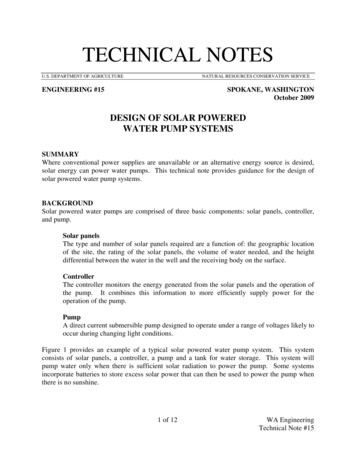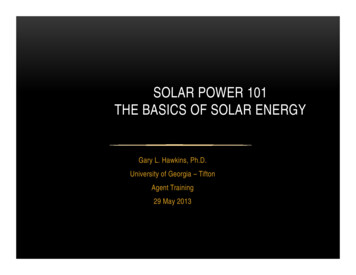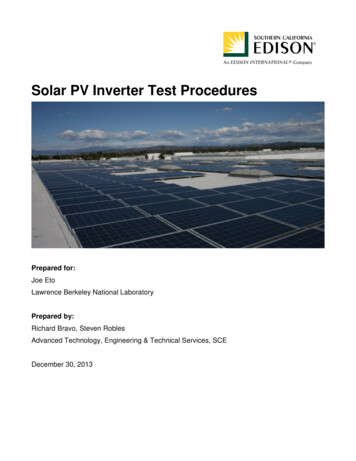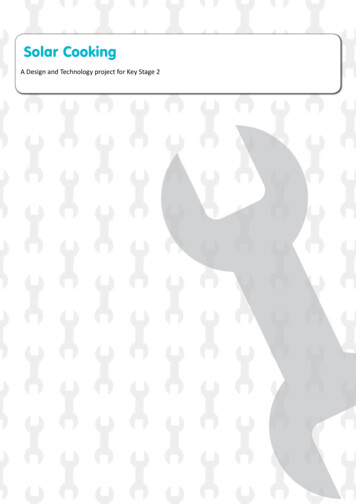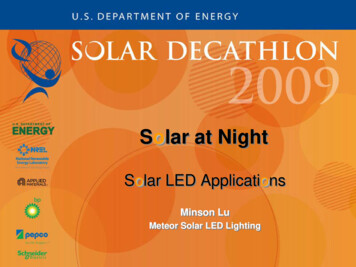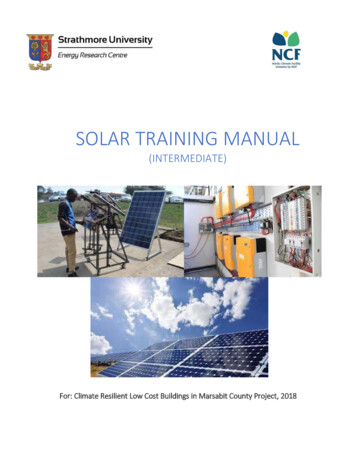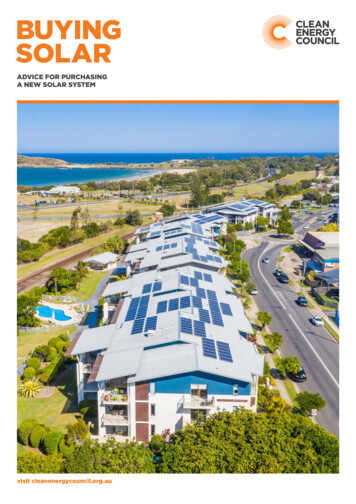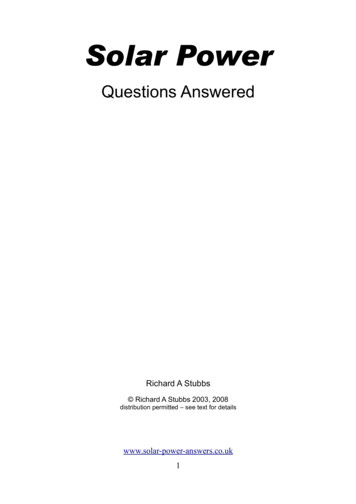
Transcription
Solar PowerQuestions AnsweredRichard A Stubbs Richard A Stubbs 2003, 2008distribution permitted – see text for detailswww.solar-power-answers.co.uk1
ContentsIntroduction.3Disclaimer.3How does a solar panel work?.4How is light turned into electricity?.4How much power?.4What can I do with the power?.5What sort of power is it?.5I’m on the mains. Can’t I have solar power then?.6So what if I’m not on the mains?.7How do I design a system?.8Optimise my loads?.8Done that, what next?.9Now then, what size does the battery need to be?.10I’m getting the hang of this, can I do the controller and inverter?.11How do I attach it all together?.12What goes where?.12How is it wired up?.13Where do I go for more help?.13To find a professional installer.13To do it yourself.13Example Wiring Diagrams.1412 Volt lighting only system.14Inverter system.15For a complete guide to designing solar power systems.The Solar Power Design Manual – Download it today.www.solar-power-answers.co.uk2
IntroductionSolar power – how does it all work? This short eBook tries to answer the mostcommon questions I was asked during my years as a renewable energy engineer.When I first started installing solar power systems I was amazed. It just seemed likemagic to me. Now I understand how solar power is used, but I still have to stop andmarvel when I see electrical power apparently falling out of the sky.Years of designing self-contained solar power systems took me all around the world,from the Scottish islands to the Amazon basin. Solar power can be made to workanywhere in the world.I’m not going to go into great technical detail because there’s no need. Light getsconverted to electrical power whether you understand the quantum physics or not.I’ve just tried to give you all the answers you need in a way that anyone canunderstand.Please feel free to make as many copies of this eBook as you like and give them toyour friends and colleagues. All I ask is that you keep it intact, do not delete ormodify any of the hyperlinks and do not charge for it.If you are serious about solar power, then you should consider my Solar PowerDesign Manual, which you can download from my website.DisclaimerEvery care has been taken to ensure that the information contained in the eBook iscorrect. However, it is based on personal experience and may not be applicable toevery situation. No responsibility is accepted for any loss suffered, either directly orindirectly, as a result of the information contained in this eBook.www.solar-power-answers.co.uk3
How does a solar panel work?That’s a big question, let’s split it into a few smaller ones.How is light turned into electricity?It’s just another form of energy conversion. Really it’s no different to burning wood;energy from the sun is turned into chemical energy in the wood. Burning the woodconverts chemical energy to heat energy.LightWhen the sun shines on a solar panel, thephotovoltaic effect converts the light energy toelectrical energy. The power from the solar panel n-typeis proportional to the amount of light shining on junctionit, that is if the light gets twice as bright, you get p-typetwice as much power.AHow much power?Well, in direct sunshine at midday, the power reaching the surface of the earth fromthe sun is a bit more than 1000 Watts per square metre.Hang on, a thousand what’s per who?I suppose it’s bound to get a bit technical. A Watt is a measure of power. It’s used forlight bulbs. A 100 Watt light bulb uses 100 Watts of power. A square metre is just that,a square 1 metre by 1 metre.So there’s enough power for 10 light bulbs on every square metre?No. Well, yes but only when it’s really sunny and even then you can’t get at it all.Remember that the light has to be converted into electricity. Quite a lot of it is lost inthis process; some is reflected away and some makes the solar panel hot. Very hot. Soall in all between 10% and 15% of the light is converted to electricity, that is 100 or150 Watts per square metre in full sunlight.But what if it’s not sunny?Good question. It doesn’t really have to be sunny, there’s always some sunlightduring the daytime, that’s how come solar power can work in Britain. If you mean“what about when it’s dark”, then that takes us onto the next question.www.solar-power-answers.co.uk4
What can I do with the power?Well, before you ask that question, you really need to know the answer to this one:What sort of power is it?In case you didn’t know, solar panels don’t generate what we call “mains electricity”.Mains is 230 Volts AC (117 Volts in the USA), while solar panels generate about 12Volts DC.AC/DC – that’s a heavy metal band isn’t it?Er, yes, but they’re not the same without Bon Scott are they? AC stands forAlternating Current and DC stands for Direct Current. The important differences arethat the voltage of an AC source can be changed by using a transformer, whilst DCcan’t. On the other hand DC can charge a battery whilst AC can’t. That’s why mainsis always AC and car electrical systems are always DC.So I can’t make solar power into mains with a transformer?No, you need something called an “inverter”. But you can charge a battery.www.solar-power-answers.co.uk5
I’m on the mains. Can’t I have solar power then?Of course you can, don’t worry. You can connect solar panels to the mains using a“synchronous inverter”, and sell the extra power to the electricity company. Thegovernment may even give you a grant for doing it.What’s a synchronous inverter?It’s an electronic device that turns DC into AC and matches it to the incoming mains.Then, when there is extra power, it turns your meter backwards.I’ll have one, where do I get it?Don’t ask me, I do self-contained systems remember? Have a look at my links pageto find specialists who can tell you more. Ask me another question.www.solar-power-answers.co.uk6
So what if I’m not on the mains?You might not live in the middle of nowhere but that still doesn’t mean you can getthe mains. You might need power for a caravan or boat, or a holiday home overseas.Maybe your garage is the other side of the main road and you can’t bury a cable. Thequestions are the same.What if it’s not sunny?I reckon you know the answer by now. Charge a battery,that’s what. Then, when the sun’s not shining or you needmore power than the solar panels are producing it can comefrom the battery. If you do it right, during the day the batterywill charge up again.But I want mains, not battery power, don’t I?I don’t know, do you? You can get a lot of 12 Volt appliances now, so you might notneed mains. Truck accessory people and the like sell them. Have a look at myrecommended products and links for more information. If you really do need 230Volts AC you can use an “inverter”.That’s the thing that sells electricity isn’t it?That’s a synchronous inverter, this is a bit different. Instead of being connected to thesolar panels, a stand-alone inverter is connected to the battery. It does the same sort ofthing except it generates its own “mains” power. Solar power answers has a page allabout inverters.So, a solar panel, a car battery and one of these inverter things then?If you like, but it won’t work very well or for very long. You see, there probablywon’t be the right amount of power, and the battery won’t last very long. Tounderstand more, let me show you how to design a solar power system.www.solar-power-answers.co.uk7
How do I design a system?Well, you start at the beginning. Actually that’s not strictly true, really you start at theend, by optimising your loads. Then you size the battery and solar array, then thecontroller and inverter. Finally you decide where all the things are going and size thecable.The following process will give you an approximation for the United Kingdom, andother countries with a similar climate. For detailed worldwide design calculations seethe Solar Power Design Manual.Optimise my loads?Yes; before you start designing you need to know that you’re designing the rightthing. That’s what optimising your loads is all about.So I should start weighing things?No, not those sort of loads. The load on the systemis the amount of power it will have to supply,averaged over time. So optimising your loads isabout reducing the number of appliances you have,reducing the time you use them for and picking theappliances with the lowest power consumption.Appliance Quantity Rating (W) Usage (h) Wh/day each Total o00Fridge1600600Other0000000000000000Total732Why would I want less appliances?It’s like this; every extra Watt of electricity or every extra hour that something’s onfor is an extra bit of solar panel, an extra bit of battery, an extra bit of controller andmaybe an extra bit of inverter. These things aren’t cheap; the way to make anaffordable solar power system is to do a good job of optimising your loads.Ok, how do I do it then?I’ve done it for you, sort of. For a rough idea, try the pop-up calculator on my designpage. Keep trying until you get the smallest possible answer.www.solar-power-answers.co.uk8
Done that, what next?You need to size the array.Size the array? What’s that?The array. That’s the term used for a number of solar panels connectedtogether. There is a maximum practical size for a solar panel so it’snormal to connect more than one together for big systems.Is there another calculator?Yup, on the same page. Beware though, it’s an approximation for theUK only. If I could predict the weather like that I’d be a millionaire.I need an array the size of Birmingham. What did I do wrong?That’s what I mean about optimising your loads. Reduce your expectations and do itagain. Keep doing this until either you realise you can’t solar power a blast furnace oryou get a sensible answer.www.solar-power-answers.co.uk9
Now then, what size does the battery need to be?Well that all depends on how many days holdover you want.Speak English man. What’s holdover?Simple, it’s the amount of time that a fully charged battery would be able to powerthe system without the solar panels. That’s your decision.Great. How do I decide?It’s 3. Well, not necessarily; for critical medical applications it’s at least 7, but for you3 will do. Don’t ask why.And there’s a calculator?Just like before, at Solar power answers there’s a battery sizing calculator.It says I need 200 Amp hours of battery, so my 500 Amp car battery will dowon’t it?A common mistake that, mostly made by the sellers of car batteries. The output of thecalculator is in Amp hours. A 200 Amp hour battery can provide 200 Amps for 1hour, 1 Amp for 200 Hours or anything that adds up to the same. The number on a carbattery is cold-cranking amps. A 500 Amp battery can provide 500 Amps for 30seconds on a cold day. Different altogether. Anyway, what you need is a deep-cyclebattery or at the least a leisure battery.Not a car battery? They’re cheap you know.I didn’t believe this myself so I tried it. Take it from me, you’ll be lucky if a carbattery lasts a month. In a car it’s always on charge so it will last for years. In a solarpower system it gets discharged daily and will break. Nope, a deep-cycle battery’swhat you want.www.solar-power-answers.co.uk10
I’m getting the hang of this, can I do the controller and inverter?That’s the next thing. Lucky it’s easy, because there’s no calculators.No calculators?No, sorry, but I’m sure you’ll manage. Let’s do the controller first.Do I really need one?Yes. Well, almost certainly. The only time you don’t need one is if you’ve got a reallybig battery relative to the size of the solar panel or array.How do I work it out?On the back of the panels there is a rating for the short circuit current. Multiply thisby the number of panels in parallel and that’s the rating of your controller in Amps.I haven’t got the panels yet have I?Oh no so you haven’t. You’ll have to approximate then. Divide the rated output (inWatts) by 16. That will give you about the right answer. If the total is less than 10%of the battery capacity you may be alright without a controller if it’s not going to beleft unattended for long periods and you’re not using sealed batteries. I wouldn’trecommend it though.What about the inverter?Even easier. Add up the Wattage of all the mains appliances that will be on at once.That’s your answer.www.solar-power-answers.co.uk11
How do I attach it all together?Get an electrician. Seriously, you need to have a certain amount of electricalknowledge before you start. If you have, then read the instructions before you startand I’ll take no responsibility if you set your house on fire. First you have to decidewhere to put things.What goes where?The solar panels need to face the south, or the north if you’re south of the equator.Can I mount them flat?No, because you’ll have to keep cleaning them. Tilt them at about your angle oflatitude, or at least 10 degrees.And the batteries?Protected from the elements, but well ventilated. They produce hydrogen gas whencharging and it’s highly flammable.And the electronics?Nice and close, preferably indoors. You need to keep the cables as short as possible.Why do the cables need to be short?Because they’re low voltage cables remember. If you half the voltage then youdouble the current, so our current is about 20 times what it would be if it was mains.Why do I care about the current?Because it determines the thickness of the cables and that determines the cost. Onceagain there’s a calculator which will help.www.solar-power-answers.co.uk12
How is it wired up?Pretty much the same as the mains really. The 12 Volt stuff will need thicker cablethan you would imagine; use the calculator to get an idea. Earth the battery negativeand make sure that the 12 Volt and 230 Volt wiring is kept completely separate.Why is that so important?To make sure that you can never have 230 Volts on the 12 Volt circuit, that’s why.You could get a nasty shock.What fittings do I use?Some mains fittings, some special ones. Look at the wiring page for moreinformation.Can you give me an idea?Of course, look at the sample wiring diagrams on the next page.Where do I go for more help?To find a professional installerYou could start by looking at the links page of Solar Power Answers – there areplenty of links to installers all around the world.To do it yourselfDownload the Solar Power Design Manual to learn all the industry secrets fordesigning, installing and maintaining a reliable solar power installation.www.solar-power-answers.co.uk13
Example Wiring Diagrams12 Volt lighting only system.5A ControllerControllerEarth3 x 12V 8W Lamps60Wp Module12V 100Ah Batterywww.solar-power-answers.co.uk14
Inverter system8 x 60Wp ModulesController20A ControllerConsumer Unit1500W InverterInverterTo Loads100A Fuse6 x 12V 100Ah BatteriesEarthwww.solar-power-answers.co.uk15
magic to me. Now I understand how solar power is used, but I still have to stop and marvel when I see electrical power apparently falling out of the sky. Years of designing self-contained solar power systems took me all around the world, from the Scottish islands to the Amazon basin. Solar



